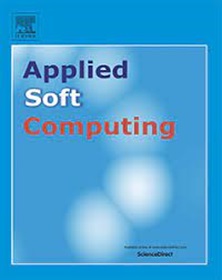通过频率分析和自适应变压器-GAN 网络为周期性离散密度缺陷绘制图像
IF 7.2
1区 计算机科学
Q1 COMPUTER SCIENCE, ARTIFICIAL INTELLIGENCE
引用次数: 0
摘要
基于深度学习的图像绘制在处理规则和相干不规则缺陷方面取得了重大进展。然而,对周期性离散密度(PDD)缺陷的研究却很少,这种缺陷普遍存在于透射电子显微镜(TEM)和扫描隧道显微镜(STM)等先进仪器获得的显微图像中。PDD 缺陷通常会在快速傅立叶变换(FFT)图像中引入低频噪声,从而阻碍提取有用信息,尤其是低频区域的信息。尽管 PDD 有重大影响,但迄今为止还没有任何方法能从高分辨率显微图像的 FFT 中有效去除 PDD 引起的噪声。在这项研究中,我们引入了一种基于生成对抗网络(GAN)和变压器块架构的新型两级网络(FGTNet),它是一种新型粗到细的涂色框架。通过整合频域和空间域的信息,我们的方法既保留了上下文结构,又生成了高频细节。我们还提出了自适应窗口转换器块(A-LeWin),以增强空间特征表示并充分利用缺陷周围的信息。为了验证我们的方法,我们构建了一个专门的显微图像数据集,其中包含 2730 个训练样本和 105 个测试样本。为了进行比较,我们还将实验扩展到了公开的可描述纹理数据集(DTD)和图像内绘领域经常讨论的相干性缺陷。实验结果表明,我们的方法在六个像素级和感知级指标上表现良好,并显示出一致性纹理的最佳性能和视觉效果。本文章由计算机程序翻译,如有差异,请以英文原文为准。
Image inpainting for periodic discrete density defects via frequency analysis and an adaptive transformer-GAN network
Image inpainting based on deep learning has made significant progress in addressing regular and coherent irregular defects. However, little has been studied on periodic discrete density (PDD) defects that are prevalent in microscopic images obtained by advanced instruments like transmission electron microscopes (TEM) and scanning tunneling microscopes (STM). The PDD defects usually introduce low-frequency noise in the fast Fourier transform (FFT) images, preventing the extraction of useful information particularly in the low-frequency regions. Despite its significant impact, no method has been reported to date to efficiently remove the PDD-induced noise from the FFT of high-resolution microscopic images. In this study, we introduced a novel GAN-based two-stage network (FGTNet), a novel coarse-to-fine inpainting framework, which is built upon the architecture of Generative Adversarial Networks (GAN) and transformer blocks. By integrating the information from both frequency and spatial domains, contextual structures are preserved and high-frequency details are generated in our method. We also proposed an adaptive-window transformer block (A-LeWin) to enhance the spatial feature representation and to fully use the information around the defects. To validate our approach, we constructed a specialized microscopic image dataset with 2730 training samples and 105 testing samples. For comparison, we also extended the experiments to the public Describable Texture Dataset (DTD) and coherence defects that are often discussed in the field of image inpainting. The experiment results indicate that our method performs well on six pixel-level and perceptual-level metrics, and shows the best performance and visual effect of coherent texture.
求助全文
通过发布文献求助,成功后即可免费获取论文全文。
去求助
来源期刊

Applied Soft Computing
工程技术-计算机:跨学科应用
CiteScore
15.80
自引率
6.90%
发文量
874
审稿时长
10.9 months
期刊介绍:
Applied Soft Computing is an international journal promoting an integrated view of soft computing to solve real life problems.The focus is to publish the highest quality research in application and convergence of the areas of Fuzzy Logic, Neural Networks, Evolutionary Computing, Rough Sets and other similar techniques to address real world complexities.
Applied Soft Computing is a rolling publication: articles are published as soon as the editor-in-chief has accepted them. Therefore, the web site will continuously be updated with new articles and the publication time will be short.
 求助内容:
求助内容: 应助结果提醒方式:
应助结果提醒方式:


